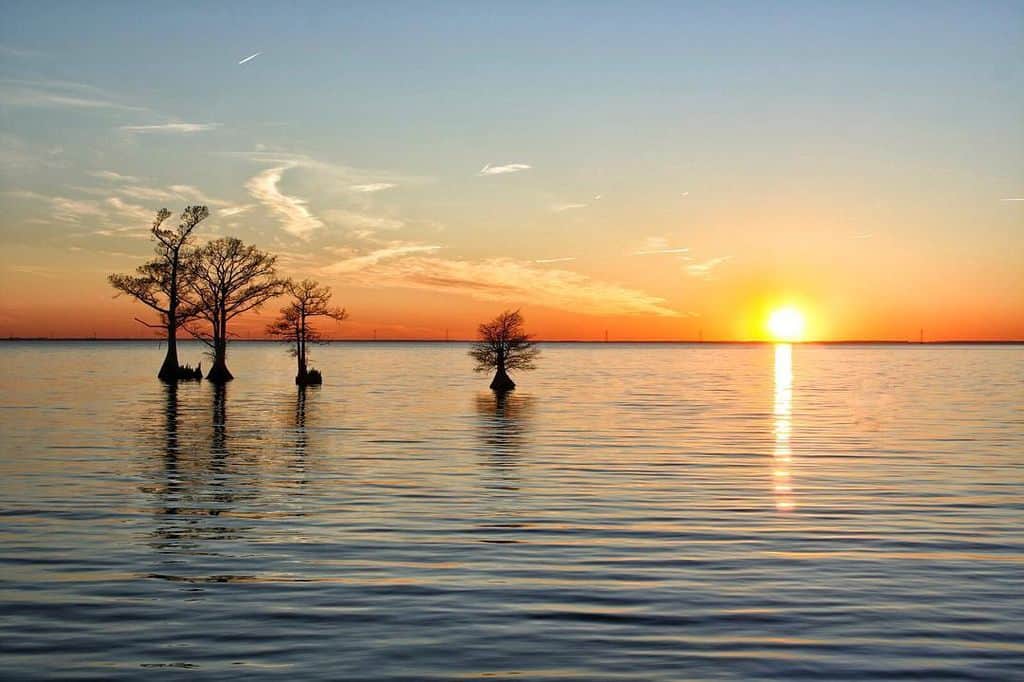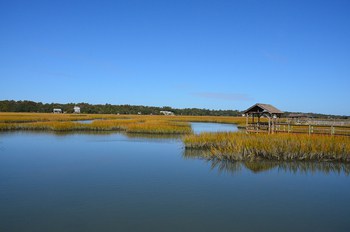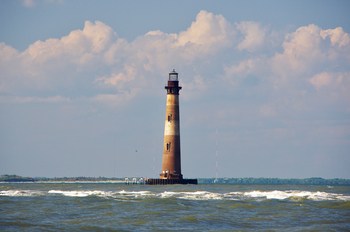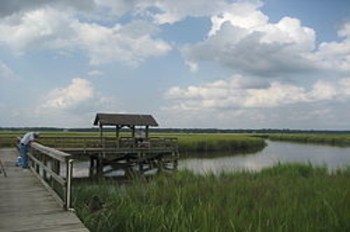Where to go Crabbing in North Carolina (The Complete Guide)
If you’re serious about getting the North Carolina experience, you seriously need to try Recreational Crabbing. The state is famous for its endless blue crabs! Whether you’re visiting the state and plan on going crabbing, or you’re a local who is looking to catch a few blue crabs, I put together this guide to help out.
When I write posts on where to go crabbing, I classify each location by crabbing methods. If you plan on going crabbing for the first time, you will want either a pier or a spot along the shoreline to use basic traps. If you’re more experienced, or ambitious, it may be better for you to go crabbing by boat.
If you want to make things as simple as can be, I recommend booking a crabbing charter. This is where a hired captain takes you and your party on their boat to catch blue crabs. With this, you don’t have to buy crabbing gear or worry about licensing. You also get to keep your catch! Click here or scroll to the bottom of this post to read about Captain Mike Park’s crabbing charter: Croatan Charters.
Regardless of how you want to go about this, I put together a map of all the spots I would use go to crabbing along the NC coast.
To save time and make things a little easier, I color-coded each spot.
- Public piers are labled with a blue pinpoint.
- Shoreline crabbing spots are labeled with a red pinpoint.
- Public boat ramps are labled with a green pinpoint.
From here, I’ll talk about Croatan Charters- a crabbing and shrimping charter hosted by Captain Mike Parks. If you decide to go crabbing on your own, I’ll go over 9 of the best public / private locations to catch blue crabs in North Carolina. Finally, I’ll finish up with different crabbing methods you can use.
Croatan Charters: Crabbing & Shrimping Charter
There’s a reason why I recommend travelers and crabbing rookies to book a charter boat. When it comes to buying crabbing or fishing gear, getting licensed, finding a spot, and everything else involved it is so easy to get overwhelmed. With a charter boat, you don’t have to worry about a thing. You get an experienced captain that knows where to catch crabs, and how to do it. Best of all, you get to keep the catch.
I’ve read outstanding reviews about Captain Mike’s Croatan Charters. He takes you and your party aboard the “Wendy Kay” to go crabbing and shrimping. You’ll spend the day pulling nets of shrimp and pots of blue crabs for a real hands-on experience. He and the crew are known to be a social bunch, and the trip is designed to be engaging for a child-friendly experience.
Read more about Captain Mike’s Croatan Charters (Affiliate Link to FishingBooker.com). Captain Mike is a quick responder and will be happy to answer any questions you may have. Be sure to read the reviews for more insight about the trip.
9 of the best crabbing spots in North Carolina
I hate labeling a certain spot as some of “the best” spots to go crabbing. You can have a bad crabbing trip at any spot. Crabs move throughout the year and you will not always bring in a good haul. I labeled these 9 spots as some of the best because they are convenient and beginner-friendly.
To add some variety, I picked spots that will work for every type of crabbing method (more on that later) and up and down NC’s coast. Keep in mind that these are just a few of many amazing spots to catch blue crabs. So, be sure to explore the map I created.
Private waterfront property
I’m writing this post for the North Carolina tourist who doesn’t know the first thing about crabbing. You need a recreational fishing license to catch blue crabs in any state. Unlike other states, North Carolina’s license costs $500 (at the time of this post) for non-residents. You’re much better off buying crabs and saving your money!
But wait! I read every letter of North Carolina’s Recreational Crabbing Regulations & Requirements (Read it for yourself). North Carolina does not require a fishing license for individuals crabbing from private waterfront property. To save money and make your crabbing experience more enjoyable, pick a house with waterfront access when visiting the state.
If crabbing from your own backyard sounds better than sharing a public spot with other crabbers, this may be for you. A crab pot may work best for catching crabs, click here to read about using one at your North Carolina waterfront spot.
Albemarle & Pamlico Sound

If you do not have a boat to go crabbing from, move on to the next crabbing spot.
The Albemarle and Pamlico sound are the two bodies of water to the left of the Outer Banks. I understand telling you to go crabbing in these bodies of water is like telling someone to go crabbing in the Chesapeake Bay. It’s a large body of water! Be more specific!
I add this crabbing spot as an option for those who want to go crabbing from a boat. These two bodies of water are perfect for catching crabs. I labeled numerous boat ramps on my crabbing map above with a green marker. Be sure to check it out to find a spot to launch your boat.
If you plan to use your boat, you will need to read North Carolina’s Boating Guide, Crabbing Regulations, and get a Recreational Fishing License. You can find all of this information on NC’s DNR website.
Historic Corolla Park
If you’re staying nearby the Corolla, Duck, and Kill Devil Hills portion of the Outer Banks, Historic Corolla Park is a great spot to go recreational crabbing. It’s a very public spot used by many and built for beginners, so I wouldn’t expect to catch in a ton of blue crabs. However, it’s an excelling crabbing spot for the experience.
You’ll be using hand lines and collapsible crab traps at this spot. There are plenty of piers and docks at the park to crab from. This park gets busy on holidays and weekends, so crabbing during the week may work best.
Besides catching blue crabs, Historic Corolla Park offers a scalable lighthouse, walking trails, and beautiful views of the Currituck Sound. This is one of, if not the best, spots to go crabbing in the Outerbanks with children.
Bebop Fishing Pier
Another spot in The Outerbanks that’s for the more serious crabber is Bebop Fishing Pier. The public pier has free parking and stretches into the crab-filled Albemarle Sound. Unlike Historic Corolla Park, this spot is best for purely collapsible crab traps.
There is not much to do besides crabbing, so a trip with kids may be better spent at another crabbing spot (see the map for more locations). There are no public restrooms or waste bins.
Cedar Street Park
As we head down the NC Coast, we find ourselves in Emerald Island. Cedar Street Park provides an excellent pier to use collapsible traps to catch blue crabs. Parking is limited but is directly at the start of the pier, which means less time carrying crab traps. There are no bathrooms or general facilities beside the pier.
Besides the excellent crabbing and fishing pier, the park is a great spot to launch kayaks and paddleboards in the Bogue Sound. The Sound has so many small islands to explore, each filled with fun sea creatures such as hermit crabs!
North Topsail Park Beach Town Park
If you’re looking the day relaxing on the beach and crabbing in Alligator Bay, this spot is for you. This park has two piers, both would work for catching blue crabs with collapsible traps. If I had to choose one, I’d pick the pier without the gazebo at the end as that one is designed for fishing and crabbing.
Besides that, the park comes with plenty of parking and facilities. The playground is in fair shape. From what I hear, the free parking fills fast. You may have to pay to park. There are public restrooms and changing rooms that are in clean shape. You also have access to walking trails and the ocean.
There’s so much to do at this spot that it doesn’t stop with just crabbing. It’s a perfect spot to bring the entire family. I love spots like this because if the crabbing gets slow, there’s always a fallback.
Soundside Park, Surf City
Just south of Northsail lies Soundside Park in Surf City. Unlike the previous spot, this park is more dedicated to crabbing and fishing. It has a boat ramp if you decide crabbing by boat is for you. There is plenty of parking for both vehicles and those with boat trailers. The park has public restrooms and waste bins.
You’ll be using collapsible crab traps along the park’s docks and piers. Aim to find a part of the dock that has water 3 or more feet deep.
If crabbing gets slow, there are playgrounds and walking trails that go over the sound. They make it perfect to enjoy the Sound’s views and see marine animals.
Southport Fishing Pier
Just south of Wilmington on the Cape Fear River lies Southport Fishing Pier. It’s a beautiful spot to go fishing or crabbing for free, as well as enjoy some of NC’s prettiest nature views. Parking at this spot is free but limited. You parallel park along E Bay street.
At this spot, you’ll be using collapsible crab traps as they work best from piers.
Besides the crabbing pier, there is a spot to enjoy the park itself. This includes public waste bins, benches, and covered picnic tables. There are no public restrooms or playground equipment as well as very limited grass space.
How to pick the best crabbing spot
You may say, “okay Taylor that’s all well and great, but which spot do I pick?” That’s a great question. It depends on how you plan on catching blue crabs. Three popular ways of catching blue crabs include a crab pot, collapsible traps, and hand lines.
Crab Pot
The method works from Public Piers, Shorelines, and Waterways.
If you’re visiting North Carolina and want to go crabbing, a crab pot is the best way to catch blue crabs. I recommend renting a home with private access to the Albemarle or Pamlico Sound and setting a crab pot. This requires no fishing license, which costs $500 for non-residents (as of September 2021).
Otherwise, you’ll need a license to go crabbing (with this method). Considering the price of a non-resident license is so high, you’ll save money by planning your vacation with a house already on the water.
If you have a boat or plan to use a crab pot in North Carolina’s open waters, you will need a fishing license. I marked over a dozen public boat ramps on the crabbing spot map with a green pinpoint. There should be a boat ramp for everyone up and down the state’s coast.
If crab pots are for you, I wrote an article: How Crab Pots Work (With Pictures) which will be an important read. You’ll need to read NC’s crabbing regulations.
Collapsible Traps
If you plan on going crabbing from a public pier, collapsible traps are your best friend. If these are new to you, I’ll briefly go over what they are and how to use them.
A collapsible crab trap is a device that lays flat at the bottom and attracts blue crabs with bait secured to the center. To activate it, you pull on the string attached to the trap, which folds the device upwards, trapping the blue crab inside. Three variations of a collapsible crab trap include box traps, pyramid traps, and ring nets.
It’s a debate about which one is best, my vote has to be the box trap, but ring nets are the cheapest and easy to use for beginners. I recommend you use a Promar Brand ring net (Affiliate link). They use a metal mesh that won’t fall apart as the conventional cotton mesh net usually does.
Since we’re crabbing in North Carolina, I made sure to link to a collapsible trap that has a width of 18 inches. Anything larger requires a recreational fishing license.
I made a guide called A Beginner’s Guide to Crabbing From a Pier. There, I explain how to use a ring net to catch blue crabs.
Hand Lines
Last but not least, the simple Hand Line. This method works best from Shorelines and Public Piers. Check the crabbing location map for these locations near you.
People have been crabbing with a string and net since crabbing started. The process is simple:
- Tie some chicken as bait to the end of cotton string at least 15 ft in length.
- Throw the bait into the water and secure the opposite end to shore.
- Wait until the line pulls tight, there’s a crab at the end!
- Slowly pull the string towards you.
- When the crab is in view, scoop him up with a dip net.
You can use any cotton string, but that may not work if the current is strong. A good fix for this is to buy a hand line (Affiliate Link). It’s a weighted bait clip designed to combat the current, keep your bait from falling off, and comes with the cotton string. There’s no limit to how many you can have in North Carolina, so buy a few in order to catch the most crabs possible! I usually can handle at least 5 or six at a time.
You will also need a dip net to scoop up the crabs. Any dip net will do as long as it has a long handle. I recommend the Plusinno dip net on Amazon (Affiliate Link). I placed small Amazon ads for each item below to display the current price.









